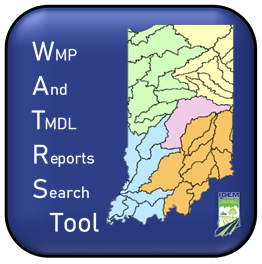A watershed plan is a strategy and a work plan for achieving water resource goals that provides assessment and management information for a geographically defined watershed. It includes the analyses, actions, participants, and resources related to development and implementation of the plan. The watershed planning process uses a series of cooperative, iterative steps to characterize existing conditions, identify and prioritize problems, define management objectives, and develop and implement protection or remediation strategies as necessary.
The main components (or chapters) in a watershed plan include:
- Public Concerns
- Watershed Inventory - includes water quality, physical, and social data
- Problem Identification
- Identify Sources of Problems
- Selection of Critical Areas
- Set Goals and Objectives
- Measure Success
The primary purpose of a watershed management plan is to guide watershed coordinators, resource managers, policy makers, and community organizations to restore and protect the quality of lakes, rivers, streams, and wetlands in a given watershed. The plan is intended to be a practical tool with specific recommendations on practices to improve and sustain water quality. These are also “living documents”, meaning that as conditions change over time in a watershed, the plan must be reexamined and revised to reflect goals that have been achieved or not met.
On this page is a list of the most current watershed management plans (WMPs) that have been approved by IDEM’s Nonpoint Source Program. These plans were written by locally-led watershed groups and serve as the first step to improving water quality in a number of Indiana’s rivers, lakes, and streams. Use the WMP and TMDL Reports Search (WATRS) Tool to find watershed planning efforts in your area. In some cases, new or updated plans may replace historical plans. Contact the Nonpoint Source Program for a full list of watershed management plans that have been completed to date.
Watershed Management Plans
Plans marked with an asterisk (*) did not meet IDEM’s checklist requirements for approval due to unexpected circumstances, but still may provide valuable information in watershed planning efforts.
Region 1 - Northwest
- Coffee Creek WMP 00-200
- Deep River-Portage Burns Waterway WMP 3-125
- Dunes Creek WMP 3-750
- Galena River WMP (LARE)
- Little Calumet River (East Branch) WMP 2-11
- NIRPC WMP 3-670
- Salt Creek WMP 6-70
- Trail Creek WMP 4-155
- Lake Manitou WMP 5-72
- Lake Maxinkuckee WMP 3-747
- Tippecanoe River (Upper) WMP 3-757
- Walnut Creek-Tippecanoe River Watershed Management Plan
- Lauramie Creek WMP 4-50
- Little Wildcat Creek WMP 00-199
- Mud Creek-Killbuck Creek Headwaters WMP 00-218
- Pete’s Run WMP 9-22
- Spring Creek-Lick Run WMP 3-736
- Stahl Ditch-Kitty Run WMP 4-145
- Turkey-Asken-Round Prairie WMP 00-218
- Wildcat Blinn (South Fork) & Kilmore WMP 5-160
- Wildcat Creek (South Fork) WMP 9-271
Middle Wabash-Little Vermillion (05120108) ![]()
Region 2 - Northeast
- Baugo Wisler WMP 01-400
- Elkhart River WMP 6-177
- Fawn River WMP 3-3
- Little Elkhart River WMP 4-142
- Little Elkhart River WMP 7-182 Addendum
- Pigeon Creek WMP 2014 Update
- Pigeon River WMP 10-86
- Puterbaugh Creek-Heaton Lake WMP 3-671
- St. Joseph River (Lake Michigan) WMP
- Upper Elkhart River WMP 58587
- Cedar Creek WMP 01-383
- St. Joseph (Lower)-Bear Creek WMP 5-73
- St. Joseph (Middle) WMP 10-65
- St. Joseph (Upper) WMP 2-16
- Limberlost-Loblolly WMP 5-115
- Treaty Creek-Wabash River WMP 21440
- Wabash River (Upper) WMP 5-74
- Wabash River (Upper), Phase II WMP 3-5
- Wabash River (Upper), Phase III WMP 25874
Region 3 - Southwest
Middle Wabash-Busseron (05120111) ![]()
- Busseron Creek WMP 7-187
- Otter Creek WMP 21678
- Turtle Creek WMP 4-151
- Turtle Creek, Turman Creek, and Kelley Bayou WMP
- Bean Blossom WMP 4-150
- Kessinger Ditch WMP 5-75
- Owen County WMP 6-171
- Plummer Creek WMP 2-13
- Prairie Creek (Daviess County) WMP 4-152
Eel (West Fork White River) (05120203) ![]()
- Patoka Lake WMP
- Patoka River (Lower) Rewrite WMP 19207
- Patoka River (Middle) WMP
- Patoka River (Upper) WMP 4-129
Lower Ohio-Little Pigeon (05140201) ![]()
Region 4 - Southeast
- Garrison Creek WMP 00-212
- Lick Creek WMP 00-212
- Salt-Pipe Creek WMP 22460
- Whitewater (Middle Fork) WMP 01-378
- Whitewater (West Fork) WMP 8-56
- Whitewater River WMP 3-119
Middle Ohio-Laughery (05090203) ![]()
- Hogan Creek WMP 5-71
- Indian Creek WMP 4-144
- Laughery Creek (Southern) WMP 3-748
- North Laughery Creek WMP 37151
- Tanners Creek WMP 00-198
- Big Blue (Lower) WMP 7-211
- Brandywine Creek WMP (LARE)
- Little Blue River WMP 5-164
- Mud Creek WMP 4-51
- Sugar Creek WMP 7-81
- Youngs Creek WMP 00-224
Upper East Fork White (05120206) ![]()
Lower East Fork White (05120208) ![]()
- Lake Monroe WMP 37065
- Lost River WMP 10-83
- Lower East Fork White River WMP 30630
- Lower Salt Creek WMP 47451
- Salt Creek-Sweetwater Creek (North Fork) WMP
- Yellowwood Lake WMP 4-46
Silver-Little Kentucky (05140101) ![]()
Region 5 - Central
- Bacon Prairie WMP 00-218
- Buck Creek WMP 00-218
- Cool Creek WMP 4-139
- Duck Creek WMP 6-155
- Eagle Creek WMP 98-002
- Fall Creek (Lower) WMP Update
- Geist Reservoir-Upper Fall Creek WMP (LARE)
- Indian Creek WMP 7-103
- Little Cicero WMP 4-140
- Little Duck Lilly Creek WMP 5-1a QA12
- Morse Reservoir-Cicero Creek WMP (LARE)
- Muncie Creek-Hamilton Ditch and Truitt Ditch-White River WMP 8-190
- Pleasant Run WMP
- Stony Creek WMP 5-161
- Swanfelt Ditch WMP 01-379
- White Lick (Lower) WMP 3-771
- White River (Delaware County) WMP 00-206
- White River Lambs Creek WMP 00-216

